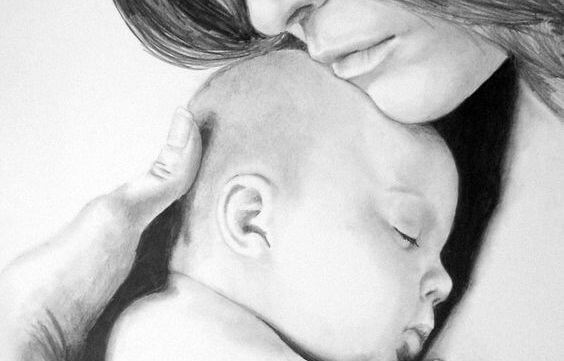Why Your Baby Should Be In Your Arms

Surely you’re tired of hearing everywhere that you shouldn’t pick up your child when they’re crying because they will “get used to your arms.” This is far from reality.
Babies need to be in your arms. We’ll explain why in this article.
Newborns need to be carried in their parents’ arms. There are still many tribes that would never consider being separated from their children.
They carry them throughout the day, even while doing other activities such as working in the fields.
Our society was once like that until the arrival of strollers and other gadgets that our consumerist, capitalist world developed.
Strollers, highchairs and other contraptions can make our daily tasks a lot easier to perform.
However, just like with everything done in excess, they can interfere with contact we are supposed to have with our children. They can eventually cause more complications than benefits.
As part of their natural development, babies pass through a phase in which their favorite place to be is in their mother’s arms. Just as with their intellectual and physical development, nurturing this phase as authentically as possible has immense benefits.
Our natural and maternal instinct inclines us to have our babies in our arms.
However, we sometimes have to listen to other mothers and grandmothers who say that it is a mistake because the baby will end up “getting used to your arms” and they will cry just to get you to hug them.

They probably cry because they need you – you are their mother. They want you to lull them, kiss them, hug them…What’s wrong with that?
Babies that are in their mother’s arms are happy babies. They cry less, complain less, eat more frequently when they have access to their mother’s breast and sleep without any problems.
It is actually their natural position, that is where they feel comfortable and safe. After being in mom’s womb for 9 months, they need to be as close to her as possible.
They have gotten used to hearing her heart. They have also gotten used to their mother’s heartbeat. That is why they relax when they get close; they remember what it was like inside the womb.
Born into a new world, they don’t know anything, they need to get used to the new rhythm and that’s why they need mom. Your arms are an emotional need for your baby.
They are an embrace, affection, a caress, security in a time of crisis. In short, it is a place of rest. It is also the best way to reinforce the bond between mother and child.
Skin to skin
Skin contact consists of immediately placing the newborn on the mother’s bare chest after birth. There is scientific evidence that backs the important benefits both in the long and short term.
After birth, babies are in a special state in which they are awake, attentive to what happens around them, with their eyes wide open. They possess an acute sense of smell and perform active reflexes.
It is imperative to recognize the importance of this moment. It only lasts for the first two hours after which a phase of lethargy begins.
During the first contact between mother and child, they observe each other, smell and touch; it is truly an unforgettable experience.
The innate smell of a mother is very important because in the first months, the baby’s vision is still deficient. They recognize their mother through her smell and her voice.
“Skin to skin contact” is carried out more and more in all Spanish maternity hospitals. This technique allows the baby to adapt to extra uterine life and maintain their body temperature which they can’t do on their own.
It also reduces the time they spend crying, strengthens the bond between mother and child, and facilitates breastfeeding. The baby instinctively searches for the nipple in order to initiate the first feeding.
In other words, from the moment the baby leaves the uterus, they need to be in the arms of their mother in order to adapt to the world.
Evidently, the father’s role is also necessary. It is true that fathers sometimes feel more insecure when it is their first child.
They observe how the mother lulls, caresses and holds the baby in her arms. However, whenever the baby needs anything, fathers can also provide their giving arms.

The Baby Carrier
There are many items on the market that help us carry our babies close to our chests while maintaining our arms free. For fathers this can be very useful. The baby can fall asleep in the carrier while you do any activity (if they are not hungry).
They will smell you, look at you and touch you, and this strengthens the bond between parent and child.
The simplest models are composed of a long piece of cloth that is knotted in different positions. There are also fabrics that come in the form of a sling knotted by rings that allow for easy change of position and size.
There are also backpack-shaped designs that combine beauty and comfort. Another option is the baby sling. It mixes the advantages of the baby carrier backpacks with an array of different positions that you will be able to choose from.

Additional benefits of baby carriers that are scientifically proven:
- Less trauma is caused during adaptation to extra uterine life
- Allows for synchronization with the mother
- They facilitate breastfeeding
- They stimulate the baby’s digestion
- Provide better rest
- Security for the mother
- Allows parents to perform other tasks
- It helps strengthen bonds
The consequences of not picking up your child enough…
If you leave the baby to cry every time they ask to be in your arms, you will be generating the following in your child:
- Stress
- Anxiety
- Insecurity
- Lack of trust
- Low self-esteem and confidence
- Individualism
- Loneliness
Mom and dad’s arms have a purpose; our children need them. So don’t hesitate to pick them up in your arms whenever they need you.
All cited sources were thoroughly reviewed by our team to ensure their quality, reliability, currency, and validity. The bibliography of this article was considered reliable and of academic or scientific accuracy.
- Vives, R. J., Lartigue, B. T., & Córdoba, A. (1992). Apego y vínculo. Comunicación preliminar. Cuaderno Psicoanal, 25, 45-53. http://bloguamx.byethost10.com/wp-content/uploads/2015/04/apego-y-vinculo-lartigue.pdf?i=1
- Dawson, G., Ashman, S. B., & Carver, L. J. (2000). The role of early experience in shaping behavioral and brain development and its implications for social policy. Development and psychopathology, 12(4), 695-712. https://www.researchgate.net/publication/12129242_The_Role_of_Early_Experience_in_Shaping_Behavioral_and_Brain_Development_and_Its_Implications_for_Social_Policy
- Guijarro, E. M. (2013). Lactancia materna y revolución, o la teta como insumisión biocultural: calostro, cuerpo y cuidado. Dilemata, (11), 169-206. https://dialnet.unirioja.es/servlet/articulo?codigo=4195869
- Harvard Women’s Health Watch. (2010). The health beneficts of strong relationships. https://www.health.harvard.edu/newsletter_article/the-health-benefits-of-strong-relationships